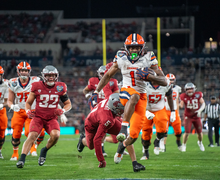Honoring New York state’s black baseball legacy
Courtesy of Onondaga County Historical Society
Jackie Robinson poses for a picture in Syracuse for a matchup with the Syracuse Chiefs.
Jackie Robinson faced near-constant racial abuse after entering the minor leagues as the first black player. During part of his minor league stint, in 1946, he played for the Montreal Royals against the Syracuse Chiefs. Many teams canceled games to prevent him from playing. Syracuse did not. Instead, National Baseball Hall of Fame records indicate, a player in Syracuse once threw a black cat on the field and shouted, “Hey Jackie, there’s your cousin.” Robinson hit a double and scored, then responded: “I guess my cousin’s pretty happy now.”
“Syracuse rode me harder than any other city in the circuit,” Robinson wrote in his 1948 autobiography, “My Own Story.” “They were tough on me both on the field and in the stands.”
April 15, 1947 is the day Robinson broke the color barrier in Major League Baseball. His rise to baseball stardom — and as a key figure in the civil rights movement, even inspiring Dr. Martin Luther King Jr. — ran through Southern California then UCLA, the Negro Leagues, and a few trips to Syracuse. All before he became the first black man to play in MLB, with the Brooklyn Dodgers.
Jackie Robinson Day, an annual MLB tradition celebrated on April 15, offers a reminder that Upstate New York has a rich history involving black baseball. There was a Negro Leagues team in Albany and exhibition games in Syracuse from the Civil War era through the mid-20th century. The effect of black baseball on integration and economy in central New York is unclear, but this much is: The game was central to black people living in the Syracuse era.

Courtesy of National Baseball Hall of Fame
After the Civil War, black baseball teams emerged across the Northeast, including in Philadelphia, New York City and Albany, said Robert Elias, a baseball historian and University of San Francisco professor whose research includes human rights.
Amateur teams traveled throughout the Northeast, central New York included, and they often tried to play against white teams. In Syracuse there were several black baseball teams at the semi-professional level, though never a Negro League team. Syracuse was a destination for barnstorming, in which teams travel around and play exhibition games, Elias said.
Larry Lester, chairman of the Negro Leagues research committee for the Society for American Baseball Research, said some New York-based Negro League teams traveled upstate to expand their fan bases, but they played primarily at Major League ballparks in larger cities.
A handful of clubs in Syracuse included players of color, both Latino and black, despite racial tensions. In 1887, the minor league team the Syracuse Stars roster included Robert Higgins, a black pitcher. A handful of other black players followed in ensuing years, Hall of Fame records indicate.

Courtesy of SABR
One organization has been invested in honoring the history of blacks in baseball since 1990. The Negro Leagues Baseball Museum in Kansas City, Missouri, is run by Bob Kendrick, who said it can be easy to lose sight of the fact that the Negro Leagues were a thriving enterprise for black people. The teams and leagues provided jobs players would not have otherwise held. Clubs that barnstormed through the Syracuse area created jobs for African Americans, Kendrick said.
The integration of the black ballplayer on the diamond was a vehicle, and a symbol, for blacks’ integration into society. The Negro Leagues themselves and related black-owned, semi-professional teams were large in size, profitable, visible and culturally relevant to black community members, Kendrick said. Desegregation on the field and in society were linked.
“Because of the success of black baseball, including in upstate New York, black business emerged,” Kendrick said. “It wasn’t uncommon for these athletes to go into a town to which they were providing economic benefit, but then they couldn’t get a decent meal or place to stay. Yet the Negro Leagues was a thriving black business, igniting economic opportunity for other businesses.
“You can directly parallel the rise and fall of the Negro Leagues with the rise and fall of black economy in our country,” Kendrick added. “Black economy, including that of cities like Syracuse, has never recovered from losing the Negro Leagues.”
To Kendrick’s point, a 2015 study by a Rutgers University professor found that Syracuse had the nation’s highest rate of extreme poverty concentrated among blacks and Hispanics. The Reviving Baseball in Inner Cities (RBI) of Syracuse program begins its 14th season this spring.
Kendrick said that rekindling passion for baseball among black kids in cities like Syracuse rests on programs such as RBI. And organizations like the Negro Leagues Baseball Museum, where the “American spirit is propelled, persevered and prevailed,” help reignite that feeling, as Robinson did several decades ago — including via his ties to Syracuse.
In an excerpt from the 2003 book entitled “The Ashes of Lou Gehrig and Other Baseball Essays,” Robinson had a shared plight with a Syracuse football player. Horace Morris, one of the first black football players at SU, was a homesick freshman in 1946. Morris met Robinson one day at New York Central train station that year. Robinson was sitting alone on a bench, while his white teammates were together on the other side of the lobby.
“I went over and told him who I was, and about my situation,” Morris said. “He looked up and said to me, ‘Kid, I’m going to make it, and you’re going to make it, too.’”
Published on April 14, 2018 at 11:37 am
Contact Matthew: mguti100@syr.edu | @MatthewGut21





